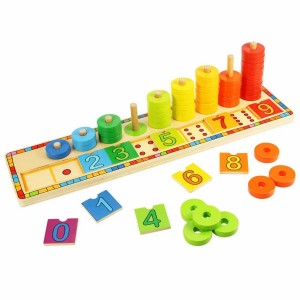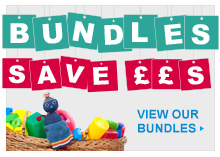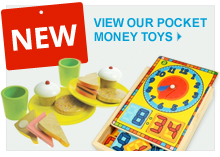
When it comes to developing mathematical skills there are several areas to deal with, but the one most people will instinctively think of is numbers.
Children begin learning numbers by rote as they do any other words. They learn the words but have no understanding of what they mean and consequently will simply recite them in whatever order they think sounds best at that moment. In order to support them to understand the ordinal value of numbers (i.e. that numbers follow a specific order) you can count as you go up and down the stairs, count before you lift your little one out of the cot, before they get out of the bath etcetera. By counting before or during anything you do together your child will establish the concept that numbers follow an order.
The next stage of numerical understanding is cardinal numbers. This is the idea that numbers represent values and that it represents the value of a set: the word and number 2 means that there are two things. For this there are all sorts of lovely toys that help, counting basic toys such as Melissa and Doug 100 Coloured Wooden Blocks is a simple way to start. For example you could count how many red blocks there are and this will also help to develop colour vocabulary.
A favourite of mine is the Bigjigs Learn to Count toy. Children can match the number with the correct number of discs that slot onto the posts and also with the number of dots that are positioned underneath the numbers. Everything is colour co-ordinated to help support the matching up of all of the numbers and discs until the little one fully understands all of the numbers.
The John Crane Tidlo Rainbow Cubes are fab because they help to develop both the cardinal and ordinal understanding of numbers. By stacking one cube on top of another with the numbers painted on children can begin to understand which number follows on from another. Each cube has the corresponding number of images of an animal on it as well which helps to develop the cardinal aspect of numbers. They also have the number written in words which helps children to understand that numbers can be written as words as well.
Once children have grasped both of these concepts they will begin to move onto simple calculations. The first operation children will deal with is addition. Once again the timeless wooden block comes into its own: ‘I have used one block and I then put another one on top. How many blocks have I used?’ By making a game out of it children won’t realise that they are completing ‘sums’. Later on you can begin to record these calculations using John Crane Tidlo Magnetic Numbers. These are great as they are very tactile and can really help those children who find it easier to learn by doing (making the number sentence on a fridge) rather than writing it down.
It is very important that you use the correct vocabulary: when we were at school we were taught that any type of calculation/number sentence was a sum. This is not correct; a sum is an addition number sentence; and the phrase the sum of the parts refers to the total of a set of numbers.










